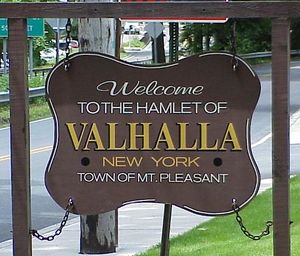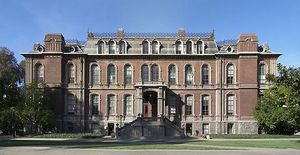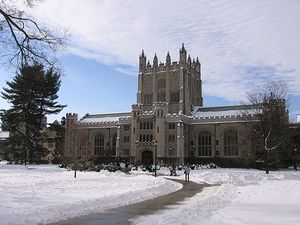Difference between revisions of "Valhalla"
| Line 22: | Line 22: | ||
</blockquote> | </blockquote> | ||
<br> | <br> | ||
| + | |||
| + | Formerly called [http://en.wikipedia.org/wiki/Kensico,_New_York Kensico], Valhalla is located in central Westchester County. It has a questionably sordid past rife with rumors of violent mysteries. | ||
| + | |||
| + | The truth, of course, is far darker. | ||
| Line 33: | Line 37: | ||
Moth Park... <blah> | Moth Park... <blah> | ||
| + | |||
| + | [http://www.worldclassmedicine.com/ Westchester Medical Center] - the region's Level I Trauma Center serving the 3.5 million people in New York's Hudson Valley region; it's an academic partner of New York Medical College and is home to NYMC's Health Sciences Library. | ||
| − | |||
| − | |||
| + | |||
| + | == The Library of St. Catherine of Alexandria == | ||
| + | [[Image:Bast-library.JPG|thumb|[http://en.wikipedia.org/wiki/Catherine_of_Alexandria St. Kate's Library].]] | ||
| + | |||
| + | The '''Library of St. Catherine of Alexandria''' has stood on the same spot in Westchester County since November 1693. As the Province of New York resolved itself into townships and evolved into cities, the library remained constant. | ||
| + | |||
| + | The current building is the most recent incarnation of the library. The original building was destroyed by fire toward the end of 1697, and again in 1714. Though the structural integrity was compromised, the majority of the contents were saved. Several other calamities befell the building, though again the major contents seemed to be spared the worst of fire, flood, storm and man. The last disaster to befall the library was entirely the work of the mad Commissioner Daly on March 29th,1893. The entire edifice was restructured at that time. | ||
| + | |||
| + | Today, the massive building is flanked by the elementary school building on one side and the high school on the other. | ||
| − | == | + | == The Academy of Saint Sebastian == |
<small>300 Columbus Avenue, Valhalla, New York 10595 * (914) 555-1661</small> | <small>300 Columbus Avenue, Valhalla, New York 10595 * (914) 555-1661</small> | ||
| + | Established in 1765, '''The Academy of Saint Sebastian''' it is one of the oldest schools (and the oldest private school) in the United States. Named in honor of [http://en.wikipedia.org/wiki/St_Sebastian Saint Sebastian], the soldier-saint and martyr who became the patron of soldiers, athletes, arrows, and plagues. | ||
| + | |||
| + | |||
| + | |||
| + | |||
| + | ===History=== | ||
[[Image:bastian_school_2.jpg|thumb|The Bastian.]] | [[Image:bastian_school_2.jpg|thumb|The Bastian.]] | ||
| + | The academy was founded by an unlikely pair: Brother Samuel Bartleby, Jesuit scholar, and Elliot Hurst, a scion of old money and titled privilege, scoundrel by nature. (There are no reliable records to substantiate Mount Pleasant Historical Society’s pet rumor that a fair number of area residents can most likely trace their lineage back to this common ancestor.) | ||
| − | + | Hurst’s relationship with his socially and politically prominent family, particularly his father, was combustible at best. His adolescent rebellion became a notorious lifestyle as he entered young adulthood. He was asked to leave every academy he attended throughout New England until entering King’s College (now Columbia University) in 1758, shortly after the university received its Royal Charter from King George II. Though established by the Church of England, the young scholar Bartleby had taken a sabbatical to do research at the new institution. | |
| − | The curriculum focuses on liberal arts and the classics, and offers over a dozen Advanced Placement classes. All students take special courses to hone their writing skills. The student:teacher ratio is 7:1, and over half the faculty hold graduate degrees. The average class size is 11. | + | It remains a mystery as to how the two met, though most agree that it was during a debate which left Hurst speechless. Impressed with the black-robed scholar’s persistence and wit, he latched onto the Jesuit with avid curiosity. |
| + | |||
| + | Although the rogue was often conspicuously absent from Sunday services, he became steadfastly devoted to his religious friend. Bartleby was the only person he seemed to respect, and the brother became his mentor and confidant. | ||
| + | |||
| + | When his father died in Hurst’s final year at the university, he seemed to experience a crisis of faith and conscience. He left the school and returned to the family estate located in what is now Mount Pleasant, accompanied by Brother Bartleby. Acting on what some called a “wild delusion brought about by guilt and grief,” Hurst secured the rights to the land surrounding the ancient Library of Saint Catherine (which he dubbed “St. Kate’s”), and established the Academy of Saint Sebastian. | ||
| + | |||
| + | The first instructors were Jesuits from Bartleby’s order, and Hurst endorsed a rigorous curriculum and a moral code of the highest order. A skilled and avid writer himself, he cherished literary pursuits above all others. He and Bartleby added entire wings to St. Kate’s through their diligent research and acquisitions from around the world. | ||
| + | |||
| + | The only thing which drew Hurst’s attention from his singular fixation on the school and library was Mary Lunette Kincade. She captured his heart and became, as he wrote, his “mate, match and inspiration.” They married and had three children together, though two died in infancy and the youngest in childbirth. He remained a faithful husband, and admitted only to his private journal that regretted the fact that he would never know whether he’d have been a better father than his own was to him. | ||
| + | |||
| + | After his wife’s death, the reclusive Hurst remained a zealous advocate of what he termed “the freedom of knowledge,” encouraging students to never fear the truth, and seek it with faith and love. | ||
| + | |||
| + | Hurst is buried in his own small crypt (apart from the ancestral Hurst resting place in Mount Pleasant proper). The plain stone crypt was commissioned by Bartleby to honor his lifelong friend’s contributions. | ||
| + | |||
| + | |||
| + | |||
| + | ===Today=== | ||
| + | The academy (co-ed since 1940) is known as St. Sebastian Elementary and St. Sebastian High School. The two institutions are only nominally associated with one another, sharing a campus divided by St. Catherine’s Library. | ||
| + | |||
| + | The curriculum focuses on liberal arts and the classics (including Latin and Greek), and offers over a dozen Advanced Placement classes. All students take special courses to hone their writing skills. | ||
| + | The student:teacher ratio is 7:1, and over half the faculty hold graduate degrees. The average class size is 11. | ||
The Bastian has a competitive athletic program with 9 varsity sports and 20 teams in total. Varsity boy's baseball and ice hockey, girl's field hockey and co-ed track teams routinely win championships and have produced a record number of professional athletes. | The Bastian has a competitive athletic program with 9 varsity sports and 20 teams in total. Varsity boy's baseball and ice hockey, girl's field hockey and co-ed track teams routinely win championships and have produced a record number of professional athletes. | ||
| Line 55: | Line 95: | ||
The Yearbook, [[Yearbook_-_St._Sebastian_High_School|''The Arrow'']], is published each year in May, and the Literary Magazine, ''The Dart'', comes out each semester. | The Yearbook, [[Yearbook_-_St._Sebastian_High_School|''The Arrow'']], is published each year in May, and the Literary Magazine, ''The Dart'', comes out each semester. | ||
| − | |||
| − | |||
| − | |||
| − | |||
Revision as of 12:21, 23 July 2009
Offspring of the Mortal Realm and the beings of Infinity.
You are without trajectory.
Without battle.
Without foes.
You are without Destiny.
Come to us, take your place in the war.
We have need of you.
Just as you have need of us.
-- from "Young Justice," Teen Titans mini-series
Contents
History
From the official Wiki page:

"...It gained its name when controversy arose over the naming of a post office in the 19th century, due to the flooding of an existing town (Kensico) now under water of the lake created by the Kensico Dam, part of the New York City Water System. According to local historians and published work, the wife of a postmaster was a devoted fan of Richard Wagner and she shared the composer's interest in Norse mythology. Her preference led to the choice of name Valhalla, after the heavenly hall of slain warriors in that mythology. The area still maintains its association with death through its world famous cemetery area...”
Formerly called Kensico, Valhalla is located in central Westchester County. It has a questionably sordid past rife with rumors of violent mysteries.
The truth, of course, is far darker.
Points of interest
From the official Wiki page:
"Valhalla is the location of the Mount Pleasant Town Hall as well as the Mount Pleasant Town Pool and Community Center. The main street in Valhalla is Columbus Avenue which runs the length of the hamlet. Along this road is the Valhalla Train Station, the Kensico Dam, Holy Name of Jesus Church as well as other shops and restaurants."
Moth Park... <blah>
Westchester Medical Center - the region's Level I Trauma Center serving the 3.5 million people in New York's Hudson Valley region; it's an academic partner of New York Medical College and is home to NYMC's Health Sciences Library.
The Library of St. Catherine of Alexandria
The Library of St. Catherine of Alexandria has stood on the same spot in Westchester County since November 1693. As the Province of New York resolved itself into townships and evolved into cities, the library remained constant.
The current building is the most recent incarnation of the library. The original building was destroyed by fire toward the end of 1697, and again in 1714. Though the structural integrity was compromised, the majority of the contents were saved. Several other calamities befell the building, though again the major contents seemed to be spared the worst of fire, flood, storm and man. The last disaster to befall the library was entirely the work of the mad Commissioner Daly on March 29th,1893. The entire edifice was restructured at that time.
Today, the massive building is flanked by the elementary school building on one side and the high school on the other.
The Academy of Saint Sebastian
300 Columbus Avenue, Valhalla, New York 10595 * (914) 555-1661
Established in 1765, The Academy of Saint Sebastian it is one of the oldest schools (and the oldest private school) in the United States. Named in honor of Saint Sebastian, the soldier-saint and martyr who became the patron of soldiers, athletes, arrows, and plagues.
History
The academy was founded by an unlikely pair: Brother Samuel Bartleby, Jesuit scholar, and Elliot Hurst, a scion of old money and titled privilege, scoundrel by nature. (There are no reliable records to substantiate Mount Pleasant Historical Society’s pet rumor that a fair number of area residents can most likely trace their lineage back to this common ancestor.)
Hurst’s relationship with his socially and politically prominent family, particularly his father, was combustible at best. His adolescent rebellion became a notorious lifestyle as he entered young adulthood. He was asked to leave every academy he attended throughout New England until entering King’s College (now Columbia University) in 1758, shortly after the university received its Royal Charter from King George II. Though established by the Church of England, the young scholar Bartleby had taken a sabbatical to do research at the new institution.
It remains a mystery as to how the two met, though most agree that it was during a debate which left Hurst speechless. Impressed with the black-robed scholar’s persistence and wit, he latched onto the Jesuit with avid curiosity.
Although the rogue was often conspicuously absent from Sunday services, he became steadfastly devoted to his religious friend. Bartleby was the only person he seemed to respect, and the brother became his mentor and confidant.
When his father died in Hurst’s final year at the university, he seemed to experience a crisis of faith and conscience. He left the school and returned to the family estate located in what is now Mount Pleasant, accompanied by Brother Bartleby. Acting on what some called a “wild delusion brought about by guilt and grief,” Hurst secured the rights to the land surrounding the ancient Library of Saint Catherine (which he dubbed “St. Kate’s”), and established the Academy of Saint Sebastian.
The first instructors were Jesuits from Bartleby’s order, and Hurst endorsed a rigorous curriculum and a moral code of the highest order. A skilled and avid writer himself, he cherished literary pursuits above all others. He and Bartleby added entire wings to St. Kate’s through their diligent research and acquisitions from around the world.
The only thing which drew Hurst’s attention from his singular fixation on the school and library was Mary Lunette Kincade. She captured his heart and became, as he wrote, his “mate, match and inspiration.” They married and had three children together, though two died in infancy and the youngest in childbirth. He remained a faithful husband, and admitted only to his private journal that regretted the fact that he would never know whether he’d have been a better father than his own was to him.
After his wife’s death, the reclusive Hurst remained a zealous advocate of what he termed “the freedom of knowledge,” encouraging students to never fear the truth, and seek it with faith and love.
Hurst is buried in his own small crypt (apart from the ancestral Hurst resting place in Mount Pleasant proper). The plain stone crypt was commissioned by Bartleby to honor his lifelong friend’s contributions.
Today
The academy (co-ed since 1940) is known as St. Sebastian Elementary and St. Sebastian High School. The two institutions are only nominally associated with one another, sharing a campus divided by St. Catherine’s Library.
The curriculum focuses on liberal arts and the classics (including Latin and Greek), and offers over a dozen Advanced Placement classes. All students take special courses to hone their writing skills. The student:teacher ratio is 7:1, and over half the faculty hold graduate degrees. The average class size is 11.
The Bastian has a competitive athletic program with 9 varsity sports and 20 teams in total. Varsity boy's baseball and ice hockey, girl's field hockey and co-ed track teams routinely win championships and have produced a record number of professional athletes.
The school colors are red and black.
The Yearbook, The Arrow, is published each year in May, and the Literary Magazine, The Dart, comes out each semester.

